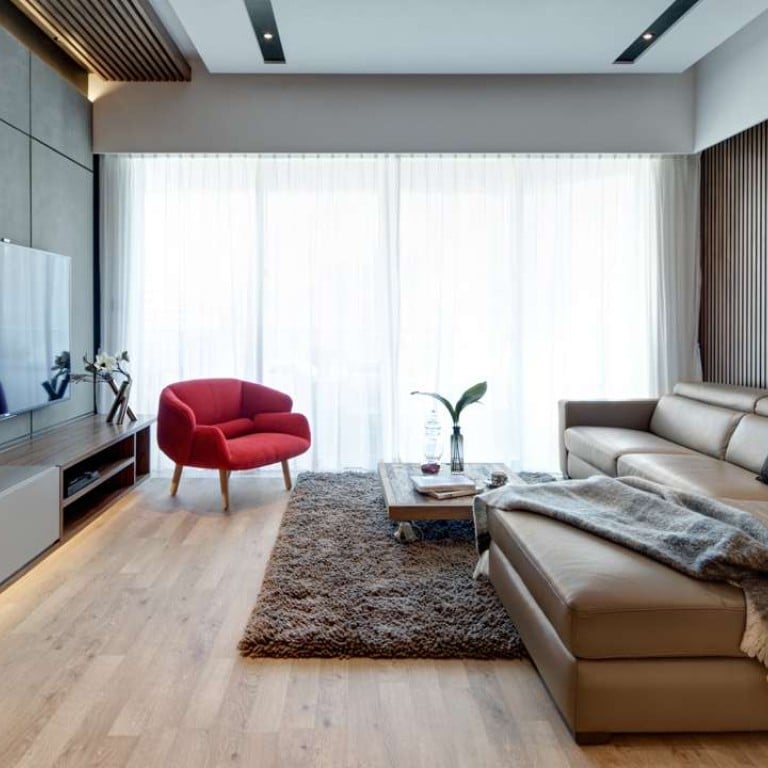
Hong Kong flat gets industrial theme with wood, concrete and pops of colour
Contrasting modern textures combine to create a warehouse vibe
Siam came home one day and, out of the blue, told me she’d sold our flat,” laughs Englishman James Forbes-May, who has been living in Hong Kong for eight years and runs an IT sales team. “We had two months to find somewhere else to live.”
And so began the journey that led the couple to the 2,300-sq-ft apartment in Olympic, Kowloon, they now call home. They had lived in the neighbourhood years previously so they knew and liked the area. Forbes-May was also keen to find a place that didn’t have empty land next to it.

“I love reading home magazines and watching property shows,” she says. “I had lots of ideas – almost too many; for example, we didn’t need so many bedrooms so one of them became my walk-in wardrobe.”
Choosing an interior designer was also a no-brainer. Fung had been Tik Chan’s first client when he started his company, Studio 93, in 2010 and they had worked together on several projects. For Fung’s latest venture, they ripped everything out, reducing the property to a basic shell.
“Siam had so many great ideas and it was my challenge to find interesting ways of incorporating them,” Chan says. “She loves the warmth of natural wood so I came up with the slatted panelling. It runs through the flat, giving consistency of design, and balances the cooler look and feel of the concrete and marble.
“We were initially worried that the walnut wood would be too dark but, fortunately, that’s not the case. You can feel the design flow from the living room all the way through to the bedroom.”
The odd splash of red adds warmth to the living room, too. For a feature wall in the master bedroom, Fung chose lime-green panels, a contemporary contrast to the concrete wall opposite and the black door frames and detailing.
“Our previous house was all white, which got dirty after two years,” Fung says. “I wanted colour as well as something that would be simple and longer lasting. Concrete is applied by hand and can be quite difficult to get right but when it is done well, it looks amazing.”
Clever touches abound. Corner shelves in the guest-room-cum-study make use of what might have otherwise been wasted space; kitchen cupboards have been covered with a laminate that resembles concrete. There is concealed storage in the base of the master bed and by eschewing obvious handles, doors blend in with panelling. On the balcony, Fung mixed and matched Spanish-style tiles to create a quirky, colourful space.
But it is the master bathroom that is the couple’s favourite part of the flat. As well as a shower with large and small heads that can be flipped up and down, there is a capacious marble tub with picture windows on two sides.
“Some bathrooms we looked at [while flat hunting] were boxy and didn’t have any windows,” Forbes-May says. “They were really depressing and you almost couldn’t wait to get out of them. This one you don’t want to leave.”
The renovations took eight months and the couple moved into their new home just over a year ago. Delighted though they are with the result, Forbes-May isn’t entirely convinced their current dream home will be theirs forever.
“It’s not all that easy to find a good apartment in Hong Kong but I think we’ve ticked all the boxes with this one,” he says. “However, Siam has a habit of wanting to move every three years so, when I catch her looking at property magazines 18 months from now, I’ll know it’s time to get nervous.”






TRIED + TESTED
Concrete idea Fibre cement boards have been fixed to the wall behind the television in the living room. Comprising a thin layer of cement composite mixed with reinforcing fibres, it looks like real concrete but is lighter in weight, easier to install and improves sound-proofing. However, according to interior designer Tik Chan, not all fibre cement boards are created equal; good-quality boards that look authentic are hard to come by in Hong Kong. The concrete-like wall, which cost HK$55,000, including installation, was created by Studio 93.
